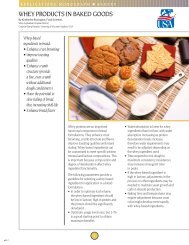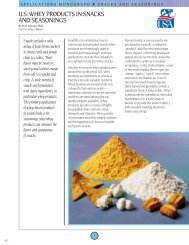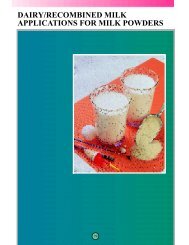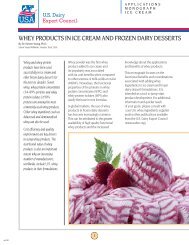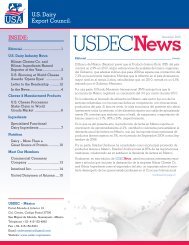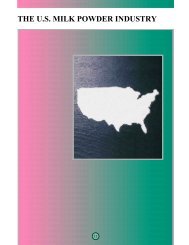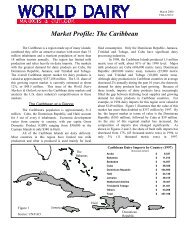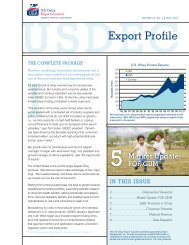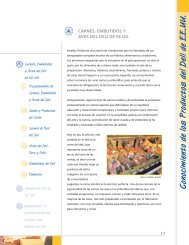Create successful ePaper yourself
Turn your PDF publications into a flip-book with our unique Google optimized e-Paper software.
5. DELI SAUSAGES<br />
Sausage making is a culinary art that man<br />
has practiced for thousands of years. It<br />
was a delicious way to preserve meat, and<br />
utilized many different cuts of meat.<br />
Through various seasonings and curing<br />
methods, sausage makers produce a vast<br />
array of sausages. In this section, you’ll<br />
learn about how sausages are made, the<br />
way they are classified, and some of the<br />
common varieties available.<br />
USDEC-USAPEEC-USMEF<br />
All ingredients in sausage are strictly controlled by the U.S. Department of Agriculture<br />
Food Safety and Inspection Service. The USDA provides detailed regulations for what can<br />
and cannot be put in a sausage and they inspect all products to be sure they comply with<br />
the regulations.<br />
Types of Meat By law, sausage must be made from good, wholesome cuts of pork, veal,<br />
beef, turkey, or chicken. Most sausages may be made using only skeletal meat, that is,<br />
meat taken off the bones. A few varieties of sausage can also be made with variety<br />
meats, such as liver or tongue. If variety meats are used, they must be listed on the label.<br />
Fat Content The amount of fat in a sausage is also controlled by federal regulations.<br />
Most sausages sold in the deli can have no more than 30% fat. Many will have less.<br />
<strong>Product</strong> labels will contain a complete nutritional breakdown, which lists the exact<br />
amount of fat and other nutrients.<br />
Ingredients All ingredients will be listed on the product label by weight, in descending<br />
order. This list must include the types of meat used, any by-products or non-meat<br />
additives, and the spices and seasonings. If the sausage is cured, the curing ingredients<br />
must also be listed.<br />
3-23<br />
U.S. <strong>Deli</strong> <strong>Product</strong> <strong>Knowledge</strong>
U.S. <strong>Deli</strong> <strong>Product</strong> <strong>Knowledge</strong><br />
3-24<br />
The use of “other” ingredients is another area controlled by the USDA. For example, a<br />
sausage product may have no more than about three percent of non-meat additives or<br />
extenders. Most sausages don’t use them at all. When non-meat additives are used,<br />
they are primarily to help “bind” the meats so they retain their smooth texture. These<br />
additives may include such things as cereal, soy protein, and whey or milk powders.<br />
Sausage Casings There are a variety of casings used to produce deli sausages<br />
including natural and artificial casings. To determine which casings are edible and<br />
which ones should be peeled before slicing or eating, review product brochures or<br />
consult your product representative.<br />
TYPES OF CASINGS<br />
Natural Casings Sausage casings were originally made from the intestines of an<br />
animal. They are known as natural casing and still used today in many cured<br />
sausages. Fresh sausages are almost always made with natural casing. One<br />
advantage of natural casings is that along with the sausage, they are edible and<br />
do not have to be trimmed from the sausage before eating. To make larger<br />
sausages it was sometime necessary to stitch together several casings to make<br />
one large enough. This tradition is still carried on today, and hand stitched<br />
casings are a sign of top quality.<br />
Artificial Casings Artificial casings for sausage have been developed for a<br />
number of reasons. Their dimension and shape can be made consistently, and<br />
they are designed to peel easily away from the sausage before they are sliced.<br />
The easiest way to remove the casing is to make a small cut around the sausage<br />
at the desired length, typically 3-6 inches (8-16 cm). Then split the casing and<br />
peel it off. With many dry sausages, especially those of coarse grind like<br />
Sopresatta, pieces of the sausage can stick to the casing as it is removed. Easy<br />
peel casings are convenient and waste little product. Cooked Bologna and<br />
Mortadella are also typically produced with easy peel casing.
Sausage Making Process Although every manufacturer has its own closely-guarded<br />
formulas and techniques for making sausage, there is a general process that all<br />
manufacturers follow to make sausages. The basic procedure is to:<br />
� Chop or grind the meat (or meats)<br />
� Mix the meat with other ingredients to<br />
form a meat batter<br />
� Stuff the meat batter into a tube-like<br />
container or casing to make links<br />
� Processed by cooking, smoking,<br />
fermenting, and curing or drying the<br />
sausage.<br />
Types of Sausage There are over 200 different styles of sausage sold in the U.S. and each<br />
one is different. However, sausages are grouped into certain classifications, according to<br />
the way they are processed. The major classifications of deli sausages include:<br />
TYPES OF SAUSAGE<br />
Fresh Sausages When these sausages are not cooked, they are usually sold in<br />
the meat department. Made of fresh meat that has not been cooked or cured.<br />
They include sausages like fresh Polish Kielbasa Sausage, Italian Sausage, Fresh<br />
Breakfast Sausage, Bratwurst, and others. If in doubt about whether a sausage is<br />
cooked or not, check the package label—it will designate if it is “fully cooked.”<br />
Fresh Cooked Sausages Made from fresh meat that is usually cured first, and then<br />
finely ground or emulsified (some varieties, like Bratwurst, are not cured.) After the<br />
sausages are stuffed into casings, they are steamed or cooked in water. Varieties<br />
include Bockwurst (pre-cooked), Bratwurst (pre-cooked), Braunsweiger, and Liver Sausage.<br />
Fresh Cooked & Smoked Sausages These are made from fresh meat that is<br />
usually cured first, and then ground. It may be either finely ground, as in<br />
Bologna, or coarsely ground, as in Beef Salami.<br />
USDEC-USAPEEC-USMEF<br />
After stuffing, these sausages are cooked, and sometimes smoked. This is the<br />
largest and most popular of all the sausage categories. Bologna producers alone<br />
make close to 900 million pounds (408 thousand mt) of Bologna each year.<br />
Other varieties include Hot Dogs, Beef Salami, Cotto Salami, Kielbasa,<br />
Knackwurst, Polish Sausage, Vienna Sausages, and many others.<br />
continued on the next page<br />
3-25<br />
U.S. <strong>Deli</strong> <strong>Product</strong> <strong>Knowledge</strong>
U.S. <strong>Deli</strong> <strong>Product</strong> <strong>Knowledge</strong><br />
3-26<br />
TYPES OF SAUSAGE (CONTINUED)<br />
Sausage Curing Sausages are cured differently depending on the style of<br />
sausage being made. The best sausages are cured long and slow to develop their<br />
full flavors. During the curing process certain beneficial molds and bacteria<br />
break down the protein structure of the meat and make it more tender as it<br />
cures. These molds and bacteria also help develop the flavors unique to cured<br />
sausages like Genoa, Hard Salami, Sopresatta, and others.<br />
Visible Mold Cured meats and sausage often develop mold that is visible on<br />
the surface of the meats or sausages as they are aging. As with cheese, mold<br />
plays a key role in the curing process. Mold produces enzymes and the enzymes<br />
act as catalysts in curing and tenderizing the meat. Although these molds are<br />
not harmful, many people do not like seeing them. Accordingly, most sausages<br />
have any visible signs of mold removed before final packaging of the product.<br />
Many traditional European style sausages have a visible white mold that<br />
develops on the surface as they cure. Often, these products are sold with the<br />
white mold still on the product. Examples include many types of Specialty Italian<br />
Sausages and Hungarian Style Sausages.<br />
Semi-Dry Sausages These sausages are made from fresh meat that is cured<br />
during processing, then almost always smoked and cooked. After cooking, these<br />
sausages are fermented by treating them with beneficial bacteria or “culture” to<br />
preserve them and give them a distinctive tangy flavor. Semi-dry sausages have a<br />
softer texture and are moister than dry sausages. Major varieties include<br />
Summer Sausage, Lebanon Bologna, and Thuringers.<br />
USDEC-USAPEEC-USMEF<br />
continued on the next page<br />
USDEC-USAPEEC-USMEF
TYPES OF SAUSAGE (CONTINUED)<br />
Dry Sausages Made from fresh meat that is cured during processing,<br />
sometimes lightly smoked, then fermented and dried. The main difference<br />
between semi-dry and dry sausages is the firmer texture. Sometimes dry<br />
sausages are not cooked. Instead, after fermenting, they are air-cured from<br />
several weeks to three months or a year.<br />
The longer and slower the curing process, the more consistent the texture of the<br />
sausage. A sausage that has cured and dried too quickly will be soft on the<br />
inside and hard on the outside rind. One that has cured more slowly will be<br />
consistently firm from the center to the outside rind. This long curing process<br />
typically makes dry sausages cost more than other sausages. Some popular dry<br />
sausages include:<br />
� Pepperoni Pepperoni is a<br />
sausage that typically combines<br />
pork, beef, cayenne pepper,<br />
salt, garlic, and other spices,<br />
giving it a big, spicy flavor.<br />
With the huge popularity of<br />
pizza in the U.S., and the world,<br />
Pepperoni is a very popular deli<br />
sausage.<br />
USDEC-USAPEEC-USMEF<br />
� Genoa Salami Usually produced<br />
from pork but sometimes made with the addition of small amounts of beef.<br />
Lightly spiced and never smoked, a good Genoa has subtle flavors. Genoa<br />
also requires a long, slow curing and drying process. Its texture should be<br />
consistent throughout with a semi-dry texture, softer than hard salami.<br />
� Hard Salami Originally made near Czechoslovakia, Poland, and Germany,<br />
hard salamis were primarily made from beef and sometimes a smaller amount<br />
of pork. The higher portion of beef accounts for the more burgundy color of<br />
most hard salami. The meats are a medium grind that is spiced with salt,<br />
pepper, garlic and other spices. Hard salami is also typically smoked and has a<br />
dry firm texture.<br />
� Sopressata An Italian-style sausage made from a coarse grind of pork, often<br />
seasoned generously with coarse ground black pepper.<br />
3-27<br />
U.S. <strong>Deli</strong> <strong>Product</strong> <strong>Knowledge</strong>
U.S. <strong>Deli</strong> <strong>Product</strong> <strong>Knowledge</strong><br />
3-28<br />
6. LUNCHEON MEATS<br />
A special category often referred to as “cold cuts.” Luncheon meats are different<br />
from other sausages because the meat is typically formed into loaves, rather than<br />
put into casings.<br />
Luncheon meats are made from fresh meats that are cured, then either chopped finely<br />
or emulsified. Once made, the meat batter is then formed into loaves and cooked or<br />
baked. To give Luncheon meats unique flavors, spices and special ingredients, like<br />
olives, pickles, peppercorns, or cheese, are often added. Luncheon meats are almost<br />
always sold sliced for sandwiches.<br />
There are a number of styles of luncheon meats. Some varieties include:<br />
� Ham and Cheese Loaf<br />
� Minced Ham, Chopped Ham<br />
� Olive Loaf<br />
� Pickle and Pimento Loaf<br />
� Head Cheese<br />
USDEC-USAPEEC-USMEF



